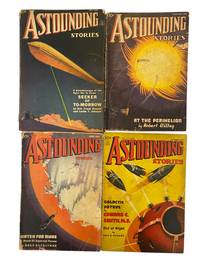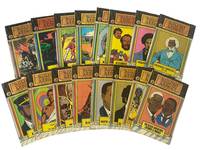by Black Troops, WWII
African American soldiers at a Fort Huachuca, Arizona U.S. Army Base During World War II. Circa. 1942–1945. Archive of 23 silver gelatin photographs each measuring approximately 3.25" x 2.25". Striking vernacular photo archive documenting African American enlisted men serving in the segregated United States Army during World War II at Fort Huachuca, Arizona, the largest training facility for Black troops during the war. The photos depict uniformed soldiers in a range of off-duty poses, formations, and candid camaraderie, with multiple images showing the men posing beside a 1939 Mercury Eight with 1942 Arizona license plates. Fort Huachuca was the wartime home of the 92nd Infantry Division (Buffalo Soldiers) and the 93rd Infantry Division, as well as the famed Triple Nickles (555th Parachute Infantry Battalion).
The men appear in standard-issue Army Service Uniforms (ASU). Several are armed with M1903 Springfield rifles, the bolt-action service rifle commonly issued during W.W.II . A number of photos show the soldiers standing at ease with rifles slung or shouldered. Notably, the troops appear relaxed, confident, and expressive—photographed alone, in pairs, and with visiting civilians (including stylishly dressed Black women)—offering a rare glimpse into the private lives and personal dignity of Black soldiers serving in a racially segregated military. Architecture in the background includes typical WWII-era temporary barracks construction, with horizontal wood siding, narrow porches, and open yards—hallmarks of Fort Huachuca’s built environment. Multiple shots feature the aforementioned 1939 Mercury Eight, a luxury coupe.
Photographs generally well-preserved, though with some minor curling and light surface wear; a few with small stains, creases, or faint silvering to edges. No annotations or identifying marks on versos. A compelling and visually rich record of African American military life during World War II. This archive offers rare documentation of the daily presence, community, and pride of Black servicemen at a time when their contributions were marginalized within the historical record. Of particular interest to scholars of African American military history, WWII homefront studies, and visual culture of the segregated armed forces. (Inventory #: 21990)
The men appear in standard-issue Army Service Uniforms (ASU). Several are armed with M1903 Springfield rifles, the bolt-action service rifle commonly issued during W.W.II . A number of photos show the soldiers standing at ease with rifles slung or shouldered. Notably, the troops appear relaxed, confident, and expressive—photographed alone, in pairs, and with visiting civilians (including stylishly dressed Black women)—offering a rare glimpse into the private lives and personal dignity of Black soldiers serving in a racially segregated military. Architecture in the background includes typical WWII-era temporary barracks construction, with horizontal wood siding, narrow porches, and open yards—hallmarks of Fort Huachuca’s built environment. Multiple shots feature the aforementioned 1939 Mercury Eight, a luxury coupe.
Photographs generally well-preserved, though with some minor curling and light surface wear; a few with small stains, creases, or faint silvering to edges. No annotations or identifying marks on versos. A compelling and visually rich record of African American military life during World War II. This archive offers rare documentation of the daily presence, community, and pride of Black servicemen at a time when their contributions were marginalized within the historical record. Of particular interest to scholars of African American military history, WWII homefront studies, and visual culture of the segregated armed forces. (Inventory #: 21990)






